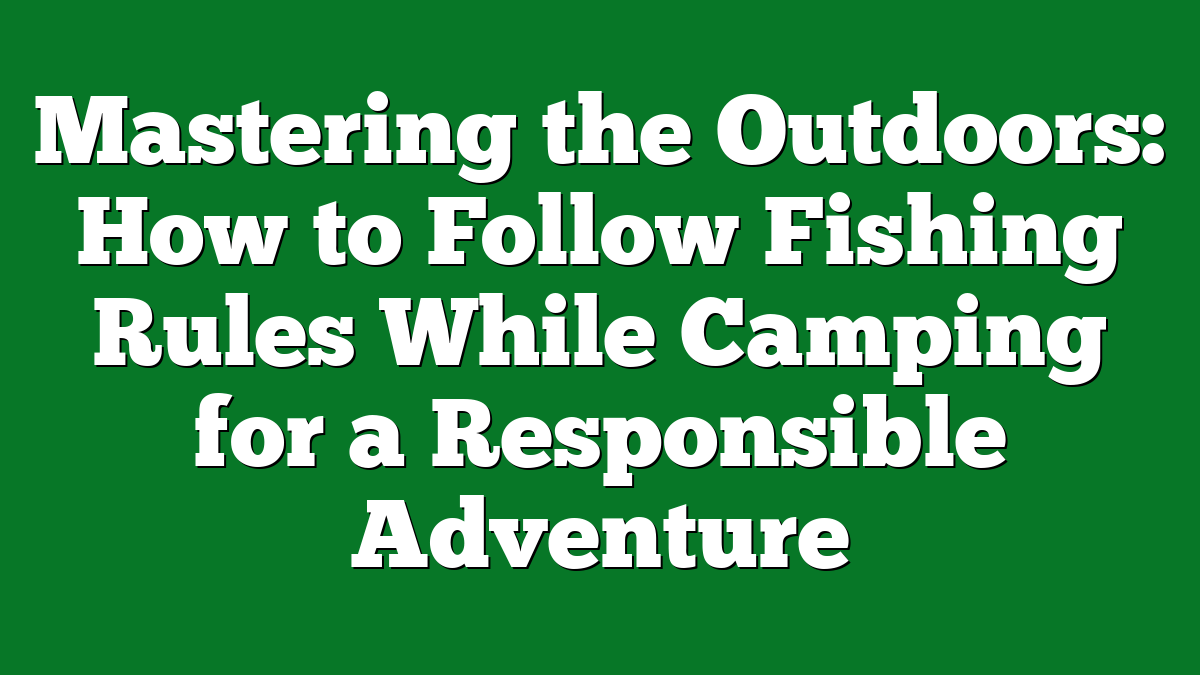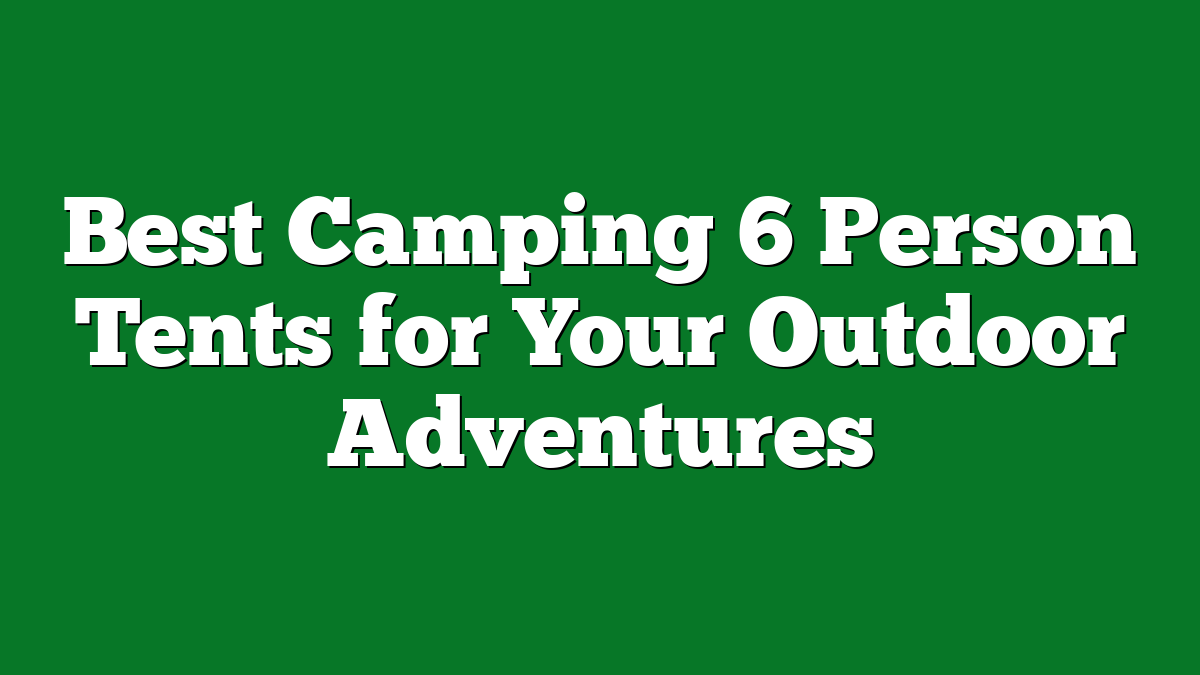Camping and fishing go hand in hand, creating the perfect recipe for adventure and relaxation. There’s nothing quite like casting a line into a serene lake or river while surrounded by nature’s beauty. But before you dive into this outdoor experience, it’s crucial to understand the fishing rules in your area. Following these regulations not only helps preserve the environment but also ensures a fair and enjoyable experience for everyone.
I’ve learned that staying informed about local fishing guidelines can enhance your camping trip. Whether you’re a seasoned angler or a first-time fisherman, knowing the do’s and don’ts keeps you compliant and helps protect our precious waterways. So let’s explore some essential tips on how to follow fishing rules while camping, ensuring that your outdoor escapade is both fun and responsible.
Understanding Fishing Regulations
Understanding fishing regulations ensures a safe and enjoyable experience while camping. I find that grasping these rules not only benefits the environment but also enhances the experience for everyone involved.
National Fishing Laws
National fishing laws set the foundation for fishing activities across the country. These laws include guidelines on fishing seasons, catch limits, and licensing requirements. For instance, the U.S. Fish and Wildlife Service regulates migratory fish species, while the National Oceanic and Atmospheric Administration oversees saltwater fishing. Familiarizing yourself with these laws helps ensure you’re fishing legally and ethically.
State-Specific Regulations
State-specific regulations offer more detailed rules tailored to local environments and fish populations. Each state has distinct fishing licenses, specific seasons, and size or bag limits for various species. For example, trout fishing might be open year-round in one state but restricted in another. I recommend visiting your state’s wildlife agency website for updated regulations, as they often provide maps, fishing forecasts, and resources tailored to local waters. Following these regulations guarantees you’re contributing to fish conservation and enjoying the great outdoors responsibly.
Essential Camping and Fishing Equipment
When I gear up for a camping and fishing trip, I focus on packing the right equipment. Having the essentials makes all the difference in creating a successful outdoor experience. Here’s what I consider crucial for both activities.
Required Fishing Gear
- Rod and Reel: I choose a versatile spinning rod and reel combo. It’s easy to use for various fishing types and techniques.
- Tackle Box: I carry a tackle box equipped with various hooks, lures, and weights. This ensures I’m prepared for different fish species.
- Fishing Line: I opt for a high-quality fishing line, as it’s your connection to the fish. A 10-20 lb test line works well for most freshwater situations.
- Fishing License: I never forget my fishing license. Checking state-specific regulations is crucial to fishing legally and responsibly.
- Fish Finder: When available, I use a portable fish finder. It helps pinpoint fish locations and improves my chances of a successful catch.
- Net: I always bring a landing net for easy catch and release. It minimizes harm to the fish, supporting conservation efforts.
Camping Essentials for Fishermen
- Tent: I choose a spacious, weather-resistant tent that accommodates all my gear. A good tent keeps me dry and comfortable.
- Sleeping Bag: I bring a sleeping bag rated for the season. Staying warm at night is essential for a restful sleep during my camping trips.
- Camping Stove: I rely on a portable camping stove for cooking meals. A reliable stove simplifies meal prep after a long day of fishing.
- Light Source: I pack a headlamp or lantern for illumination. They help navigate and set up camp after dark.
- First Aid Kit: I always carry a first aid kit tailored for outdoor adventures. It’s useful for treating minor injuries or incidents while camping.
- Cooler: I take a sturdy cooler for storing perishable food and keeping my catch fresh until I return home.
By preparing with the right equipment, I ensure a more enjoyable and fulfilling camping and fishing experience.
Best Practices for Responsible Fishing
Following responsible fishing practices ensures both enjoyment and preservation of our natural resources. By adhering to these guidelines, I promote sustainability while enhancing my outdoor adventures.
Catch and Release Techniques
Catch and release fishing is an excellent way to enjoy the thrill of fishing while protecting fish populations. I practice gentle handling to reduce stress on the fish. I use barbless hooks, making it easier to release caught fish without injury. I keep the fish in water as much as possible while removing hooks. If I need to take a photo, I minimize the time out of water, ensuring they’re back in their habitat quickly. Observing these methods not only helps replenish fish stocks but also allows me to enjoy the sport without depleting resources.
Maintaining Clean Campsites
Keeping campsites clean is crucial for both my enjoyment and environmental stewardship. I use designated trash bins or pack out all waste, including fishing line and bait containers. I avoid disturbing local wildlife by storing food securely and minimizing noise. Additionally, I respect sensitive areas by staying on established trails and campgrounds. By leaving the site cleaner than I found it, I contribute to the well-being of the ecosystem and ensure a pleasant experience for fellow campers.
Resources for Checking Fishing Rules
Understanding fishing rules is crucial for a successful camping trip. Numerous resources make checking these regulations easier and maintain my commitment to responsible outdoor practices.
Online Databases and Websites
I often rely on website resources like Fish and Wildlife agencies, which offer comprehensive databases for fishing regulations. For example, the National Oceanic and Atmospheric Administration (NOAA) provides federal guidelines for coastal fishing, while the U.S. Fish and Wildlife Service outlines national regulations for freshwater fishing. State-specific websites, like California Department of Fish and Wildlife or Florida Fish and Wildlife Conservation Commission, supply updated information on licensing, seasons, and catch limits. Bookmarking these sites helps me access regulations quickly before heading out.
Local Fishing Guides
Local fishing guides play a vital role in my preparation process. These experts share invaluable insights on local rules and conditions, including seasonal changes and wildlife management practices. Engaging a guide offers me a structured way to learn the latest rules and find the best fishing spots in the area. Additionally, tackle shops often have bulletin boards or staff that stay informed about current regulations, including any temporary changes. Using these resources keeps me informed and promotes ethical fishing practices.
Staying knowledgeable about fishing regulations helps enhance my camping and fishing experiences while ensuring I respect the environment and local wildlife.
Conclusion
Fishing while camping is an incredible way to connect with nature and enjoy the great outdoors. By following local fishing rules and guidelines, we not only protect the environment but also ensure that everyone can share in the joy of fishing. It’s all about being responsible and respectful to our surroundings.
I’ve found that when I take the time to prepare and understand the regulations, my camping trips become even more enjoyable. So let’s keep our campsites clean and our fishing practices sustainable. Together, we can create memorable experiences while preserving the beauty of nature for future generations. Happy fishing and camping!











